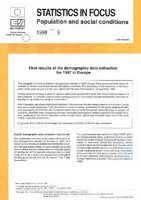| dc.description.abstract | The population of most countries in Europe grew slightly in 1997, though there continued to be some decreases in certain central and eastern European countries. The population of the countries of the European Union grew by just 0.2 per cent, about half the rate of increase in, for example, 1980. Fertility rates are tending to level off, albeit at well below replacement level, with some small increases in a few countries. In contrast, births outside marriage continue to increase virtually everywhere, basically reflecting the growing popularity of cohabitation. Infant mortality has shown significant declines in Europe over the last twenty years to 4 to 6 infant (under one year of age) deaths per 1000 live births in many countries, particularly in the north, south and west. Live expectancy at birth has also increased with levels currently for women above 80 years in at least 12 countries. Mortality rates, particularly for men, have also improved in a number of eastern European countries, particularly the former Republics of the Soviet Union, which saw mortality rates rise in the early 1990s a period of transition. In general, the incidence of marriage has decreased and that of divorce has increased. |

